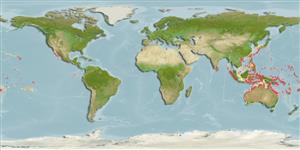>
Ovalentaria/misc (Various families in series Ovalentaria) >
Plesiopidae (Roundheads) > Plesiopinae
Etymology: Plesiops: Greek, plesios = near + Greek, ops = appearance (Ref. 45335); verecundus: Specific name refers to its lack of distinguishing features..
Environment: milieu / climate zone / depth range / distribution range
Ökologie
seewasser riff-verbunden; tiefenbereich 0 - 30 m (Ref. 27772), usually 0 - 3 m (Ref. 27772). Subtropical
Western Pacific: west coast of Sumatra to Vanuatu and Fiji, north to Taiwan and the southern Ryukyu Islands, south to Australia. Recently recorded from Tonga (Ref. 53797).
Size / Gewicht / Alter
Maturity: Lm ? range ? - ? cm
Max length : 9.5 cm SL Männchen/unbestimmt; (Ref. 27772)
Kurzbeschreibung
Morphologie | Morphometrie
Rückenflossenstacheln (insgesamt): 12; Rückenflossenweichstrahlen (insgesamt): 7; Afterflossenstacheln 3; Afterflossenweichstrahlen: 8.
Eggs are guarded by the male parent (Ref. 205). Found in reef crevices in 1-30 m (Ref 90102).
Life cycle and mating behavior
Geschlechtsreife | Fortpflanzung | Ablaichen | Eier | Fecundity | Larven
Eggs are guarded by the male parent (Ref. 205).
Mooi, R.D., 1995. Revision, phylogeny, and discussion of biology and biogeography of the fish genus Plesiops (Perciformes: Plesiopsidae). Life Sci. Contrib. No. 159, 108 p. (Ref. 27772)
IUCN Rote Liste Status (Ref. 130435)
Bedrohung für Menschen
Harmless
Nutzung durch Menschen
Mehr Information
Alter/GrößeWachstumLänge-GewichtLänge-LängeLängenhäufigkeitenMorphometrieMorphologieLarvenLarven Pop.Dyn.RekrutierungDichteBRUVS
ReferenzenAquakulturAquakultur ProfilZuchtlinienGenetikElectrophoresesVererbbarkeitKrankheitenVerarbeitungNutrientsMass conversion
PartnerBilderStamps, Coins Misc.LauteCiguateraGeschwindigkeitSchwimmstilKiemenoberflächeOtolithsGehirngrößeSehfähigkeit
Tools
Zusatzinformationen
Download XML
Internet Quellen
Estimates based on models
Preferred temperature (Ref.
123201): 24.7 - 29.3, mean 28.5 °C (based on 2147 cells).
Phylogenetic diversity index (Ref.
82804): PD
50 = 0.5000 [Uniqueness, from 0.5 = low to 2.0 = high].
Bayesian length-weight: a=0.00468 (0.00177 - 0.01234), b=3.18 (2.95 - 3.41), in cm total length, based on LWR estimates for this (Sub)family-body shape (Ref.
93245).
Trophic level (Ref.
69278): 3.5 ±0.5 se; based on size and trophs of closest relatives
Widerstandsfähigkeit (Ref.
120179): hoch, Verdopplung der Population dauert weniger als 15 Monate. (Preliminary K or Fecundity.).
Fishing Vulnerability (Ref.
59153): Low vulnerability (10 of 100).
Nutrients (Ref.
124155): Calcium = 82.9 [33.7, 178.2] mg/100g; Iron = 0.715 [0.377, 1.333] mg/100g; Protein = 19.1 [17.9, 20.2] %; Omega3 = 0.164 [0.084, 0.308] g/100g; Selenium = 10.7 [4.4, 25.6] μg/100g; VitaminA = 105 [29, 371] μg/100g; Zinc = 1.25 [0.73, 1.98] mg/100g (wet weight);
